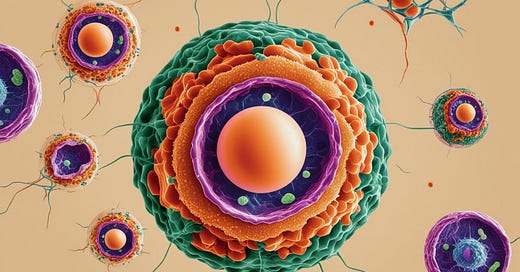When it comes to understanding ADHD in (AFAB) females, the Multiple Hormone Sensitivity Theory offers an exciting framework that connects fluctuating hormone levels with the variability of ADHD symptoms across different life stages. This theory sheds light on why girls and women with ADHD often experience hormonal challenges that differ significantly from those faced by males with the condition. Let's explore what this theory is, how it works, and why it matters.
The Basics: What is Hormone Sensitivity?
Hormones like estrogen and progesterone are powerful chemical messengers in the body. They regulate everything from mood and energy to cognition and focus. The Multiple Hormone Sensitivity Theory proposes that women —are highly sensitive to fluctuations in these hormones, which can amplify or alter the intensity of ADHD symptoms.
These hormonal changes occur during specific periods:
Monthly cycles (menstrual cycle).
Life transitions like puberty, pregnancy, and menopause.
This heightened sensitivity creates unique challenges, making ADHD symptoms more dynamic and variable than in males.
Key Hormones and Their Roles
Estrogen:
Boosts dopamine production and signaling, which supports focus, memory, and emotion regulation.
High levels (e.g., during ovulation) can improve cognitive functioning temporarily.
Drops in estrogen (e.g., before menstruation) lead to reduced dopamine activity, worsening ADHD symptoms like inattention and emotional instability.
Progesterone:
Less understood but interacts with GABA (a calming neurotransmitter).
High levels may increase irritability and sensory sensitivity.
How Hormone Sensitivity Affects ADHD Symptoms
The theory explains ADHD symptom variability through activational and organizational effects of hormones:
Activational Effects: Temporary, short-term changes caused by fluctuating hormone levels, such as mood swings during the menstrual cycle.
Organizational Effects: Long-term, structural brain changes caused by exposure to hormones during key developmental windows like puberty or prenatal development.
The Menstrual Cycle and ADHD Symptoms
The menstrual cycle is a prime example of how hormone sensitivity influences ADHD symptoms. Here’s how it plays out across the phases:
Ovulation (Mid-Cycle):
Hormonal Shift: A sharp rise in estrogen.
Effects: Increased impulsivity, hyperactivity, and reward-seeking behavior.
Why It Matters: While some may feel motivated, others might experience more restlessness and difficulty controlling impulses.
Reward seeking behavior could include spending, sex or substance use.
Luteal Phase (Late Cycle):
Hormonal Shift: Estrogen drops, and progesterone dominates.
Effects: Heightened irritability, sensory sensitivity, and mood swings.
Why It Matters: This is often when ADHD symptoms, like inattention and emotional dysregulation, become more pronounced.
Perimenstrual Phase (Right Before Menstruation):
Hormonal Shift: Estrogen and progesterone levels plummet.
Effects: Increased inattention, cognitive impairments, and emotional challenges like sadness or anxiety.
Why It Matters: This “double whammy” of estrogen withdrawal and pre-existing ADHD challenges can feel overwhelming.
Lifespan Hormonal Shifts and ADHD
The theory also highlights critical life stages where hormonal shifts play a major role:
Puberty:
Hormones like estrogen and progesterone begin to fluctuate, often worsening ADHD symptoms due to heightened emotional impulsivity and executive function challenges.
Pregnancy:
Hormone levels rise dramatically, which may stabilize symptoms for some women. However, the postpartum period brings a sudden drop in estrogen and progesterone, leading to worsened ADHD symptoms and mood changes.
Menopause:
Declining estrogen levels can cause persistent focus and mood challenges, exacerbating ADHD symptoms in older women.
The Neurobiology Behind It
At the core of this theory is the role of the dopaminergic system:
Estrogen boosts dopamine in the prefrontal cortex (responsible for focus and planning) and the limbic system (responsible for emotions).
Estrogen withdrawal reduces dopamine activity, making it harder to focus and regulate emotions.
Progesterone’s influence is less direct but still significant, as its metabolites interact with brain chemicals that affect mood and sensitivity.
Why Does the Multiple Hormone Sensitivity Theory Matter?
Tailored Interventions:
Understanding hormonal sensitivities can help clinicians create better, more personalized treatment plans for females with ADHD.
Examples include timing ADHD medication around the menstrual cycle or using hormonal therapies to stabilize fluctuations.
Awareness Among Educators and Parents:
Teachers and caregivers can better support girls with ADHD if they recognize how hormones may influence symptom variability.
Support Across Life Stages:
Providing resources and psychosocial support during critical periods like puberty, pregnancy, and menopause can help women with ADHD thrive.
Looking Ahead
The Multiple Hormone Sensitivity Theory is a game-changer in ADHD research, particularly for understanding and managing the condition in females. By considering the complex interplay between hormones and ADHD symptoms, we can pave the way for more effective treatments and greater awareness.
For anyone navigating ADHD, this framework highlights an important truth: the challenges you face are not just "in your head"—they are deeply tied to the unique ways your body and brain respond to hormonal changes.
Eng, A. G., Nirjar, U., Elkins, A. R., Sizemore, Y. J., Monticello, K. N., Petersen, M. K., Miller, S. A., Barone, J., Eisenlohr-Moul, T. A., & Martel, M. M. (2024). Attention-deficit/hyperactivity disorder and the menstrual cycle: Theory and evidence. Hormones and Behavior, 158, 105466. https://doi.org/10.1016/j.yhbeh.2023.105466
Thanks for reading the ADHD advocate.
If you like this newsletter please share it or subscribe.
Kristen McClure MSW, LCSW





